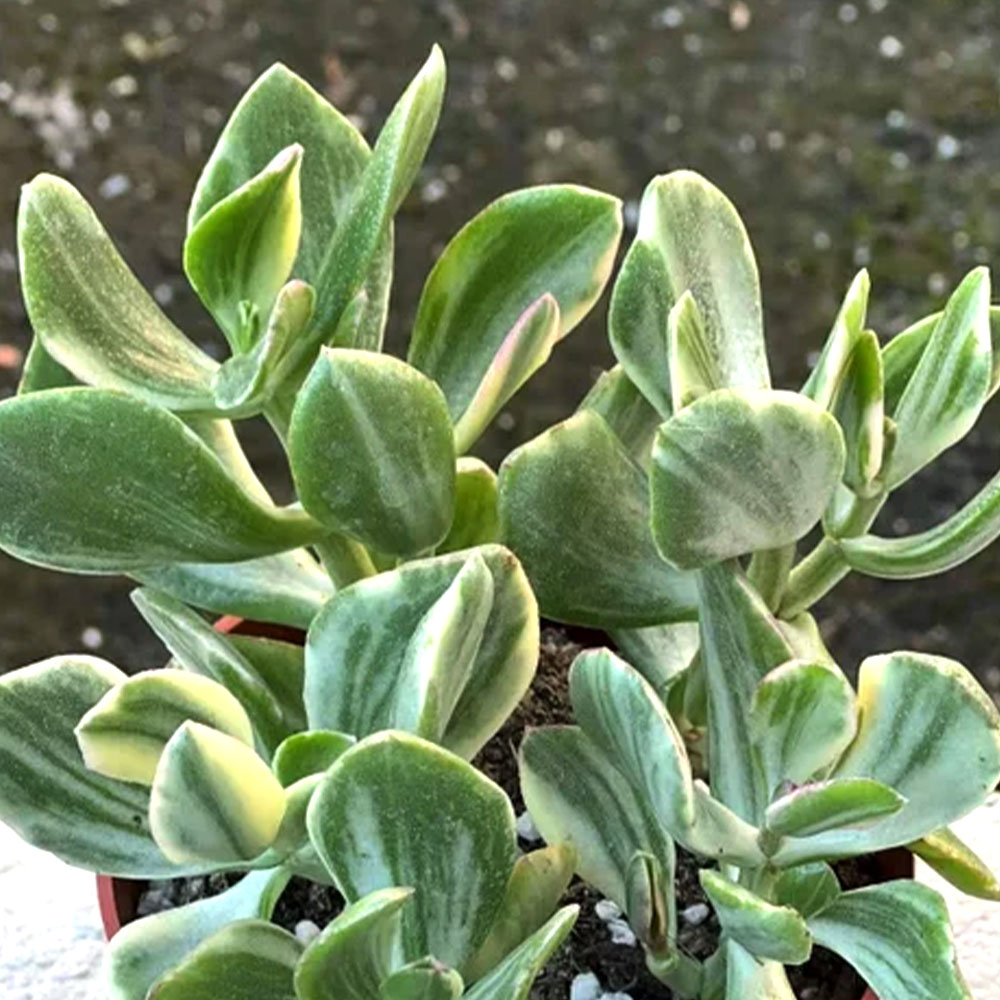No products in the cart.
Crassula ovata ‘Variegata’
White stripes and everlasting beauty
Rated 0 out of 5
0 customer reviews
4,08 €
Only 4 item(s) left in stock!
Tags: evergreen, graphique, perennial, persistant, plant, secheresse, soleil
SKU: pda377
Category: Better Indoors, Bees and Butterflies, Evergreen, Make it Pop, The Stunners
Estimated Delivery :
2-3

Crassula ovata 'Variegata'
4,08 €
Only 4 item(s) left in stock!
Crassula ovata ‘Variegata’, is a cream and white striped variation on the commonly known jade plant.
Just as drought tolerant and low-maintenance as the Jade plant, it thrives in a variety of indoor and outdoor settings, making it a perfect choice for both novice and experienced gardeners.
Its leaves are fleshy, glossy, and round, streaked with ivory bands and speckled with pale yellow.
The plant will bloom mid-winter (anywhere between December and February) once it has reached maturity.
The flowers are tiny , cream-colored stars on long pinkish-red stems.
It has a very slow growth rate but, once mature, it forms an elegant tree like structure with a thick trunk and branches. A heavy terracotta pot will keep them well grounded .
👨🌾GARDENING TIPS👨🌾:
-
- ✂️Cut them back if they get too long or too leggy – they respond well to a trim!
- ❄️ Crassula ovata does not appreciate the frost – so do make sure to bring them inside during the frosty months.
- ☀️As with all the Crassulae, Crassula ovata is extremely drought-tolerant and loves the sun. This in turn means that they hate moist soil > keep it dry
Learn more about how to care for your Crassula ovata ‘Variegata’:
The Tale & The Botany: Crassula ovata ‘Variegata’
“Crassula” means thick or fat in Latin, referring to the leaves that become plumpy the more water they are able to store.
This is a good indicator of the health of your crassula – if less plumpy, then she needs a dash of water!
This genus was first named in 1862 and the genus contains 150-200 species, most of them occurring in South Africa.
“Ovata” comes from the Latin word meaning egg-shaped. And indeed, the leaves are a little egg-like.
Variegata means, well, variegated.
🌸 Floral Morphology
Jade plants produce small, star-shaped flowers that are typically white or pale pink, often with a subtle sweet fragrance.
Flowers appear in dense terminal clusters during winter or early spring, although flowering is more common in mature, well-cared-for plants.
The leaves are opposite, oval to obovate, thick, and fleshy, ranging from bright green to deep green, sometimes developing a reddish tint on the margins in response to strong sunlight or cold.
🌱 Reproductive Biology
Crassula ovata reproduces both sexually via seeds and vegetatively through cuttings or offsets.
Flowers are hermaphroditic and attract pollinators such as bees and flies, but most propagation occurs through leaf or stem cuttings, which root readily under suitable conditions.
This vegetative strategy allows the plant to form dense, shrubby structures over time.
🌍 Ecology & Adaptations
Native to arid and semi-arid regions of southern Africa, Crassula ovata has evolved several adaptations for survival in dry environments:
-
-
Succulent leaves store water for prolonged drought periods.
-
CAM photosynthesis allows the plant to minimize water loss while maintaining metabolic activity.
-
Thick, woody stems provide structural support and enable the plant to reach up to 1–2 meters in height outdoors.
-
The plant tolerates poor, well-drained soils, full sun, and occasional frost, although it is sensitive to prolonged freezing.
-
Origin:
South Africa
| Weight | 0,5 kg |
|---|---|
| Flowering | January, February, December |
| Exposure | Full Sun |
| Frost Tolerance | -1°C to -5°C |
| Soil | Sandy, Well-Draining |
| Size | 1m H x 1m W |
Reviews
0
Rated 0 out of 5
0 customer reviews
5
0
4
0
3
0
2
0
1
0
Only logged in customers who have purchased this product may leave a review.
You may also like…
Crassula tetragona
A succulent with dark green, sword-shaped leaves.
A succulent with dark green, sword-shaped leaves.
Rated 0 out of 5
Kalanchoe pumila
A silver succulent that forms a small, clumping bush.
A silver succulent that forms a small, clumping bush.
Rated 0 out of 5
Aristaloe aristata
A evergreen flowering graphically striking succulent
A evergreen flowering graphically striking succulent
Rated 0 out of 5
Crassula ovata ‘Minor’
A branching succulent with round, color-shifting leaves.
A branching succulent with round, color-shifting leaves.
Rated 0 out of 5
Crassula perforata
A slow-growing succulent with graphic rambling stems
A slow-growing succulent with graphic rambling stems
Rated 0 out of 5
Related Products
Sedum album
A low, multi-color ground cover.
A low, multi-color ground cover.
Rated 0 out of 5
Cerastium tomentosum var. columnae
A grey-green spreading ground cover from the mountains.
A grey-green spreading ground cover from the mountains.
Rated 0 out of 5
Glechoma hederacea
A sweet smelling ground cover, producing little blue flowers all summer long.
A sweet smelling ground cover, producing little blue flowers all summer long.
Rated 0 out of 5
Artemisia vulgaris Oriental Limelight
Striking green and yellow variegated foliage.
Striking green and yellow variegated foliage.
Rated 0 out of 5
Tradescantia Blushing Bride
Gorgeous blushes of pink and white that appear in the coldest nights.
Gorgeous blushes of pink and white that appear in the coldest nights.
Rated 0 out of 5
Achillea ptarmica Boule de Neige
White pompom flowers to attract bees to your garden all summer long.
White pompom flowers to attract bees to your garden all summer long.
Rated 0 out of 5
Delosperma cooperi
A dwarf perennial known for its vermillion colored flowers
A dwarf perennial known for its vermillion colored flowers
Rated 0 out of 5
Billbergia nutans
A bromeliad featuring a three colored, striped flower
A bromeliad featuring a three colored, striped flower
Rated 0 out of 5
Erigeron kavinskianus
A daisy-like carpet of flowers
A daisy-like carpet of flowers
Rated 0 out of 5
Echinops ritro
Tall, electric blue globe thistles
Tall, electric blue globe thistles
Rated 0 out of 5
Vinca minor
Looping elegance and ability to form a low flowering ground cover
Looping elegance and ability to form a low flowering ground cover
Rated 0 out of 5
Artemisia alba subsp camphorata
A highly fragrant, grey-green bush.
A highly fragrant, grey-green bush.
Rated 0 out of 5
Jacobaea maritima
A wooly white perennial plant from the Mediterranean region.
A wooly white perennial plant from the Mediterranean region.
Rated 0 out of 5
Mentha x piperita ‘Chartreuse’
A spicy mint, known for its use in the production of liqueurs and herbal teas.
A spicy mint, known for its use in the production of liqueurs and herbal teas.
Rated 0 out of 5
Satureja montana
A sweet smelling culinary herb from Europe
A sweet smelling culinary herb from Europe
Rated 0 out of 5
Solidago ‘Golden Shower’
Beautiful showers of yellow flowers
Beautiful showers of yellow flowers
Rated 0 out of 5
Euphorbia myrsinites
Known for its draping form of silver-gray foliage and radiant blooms.
Known for its draping form of silver-gray foliage and radiant blooms.
Rated 0 out of 5
Hieracium maculatum Leopard
A native perennial with blue-green leaves and a tall yellow flower
A native perennial with blue-green leaves and a tall yellow flower
Rated 0 out of 5
recent view product
Centranthus ruber Roseus
A variation on the valerian theme – with soft pink flowers
A variation on the valerian theme – with soft pink flowers
Rated 0 out of 5
Aster novi-belgii ‘Harrison’s Blue’
Exquisite clouds of deep purple flowers.
Exquisite clouds of deep purple flowers.
Rated 0 out of 5
Campanula persicifolia ‘Telham Beauty’
A stately porcelain colored beauty
A stately porcelain colored beauty
Rated 0 out of 5
Erigeron glaucus
A flowering plant with large white-pink flowers
A flowering plant with large white-pink flowers
Rated 0 out of 5
Rosmarinus officinalis
A drought tolerant, aromatic, perennial that is the center of Mediterranean cuisin
A drought tolerant, aromatic, perennial that is the center of Mediterranean cuisin
Rated 0 out of 5
























































There are no reviews yet.